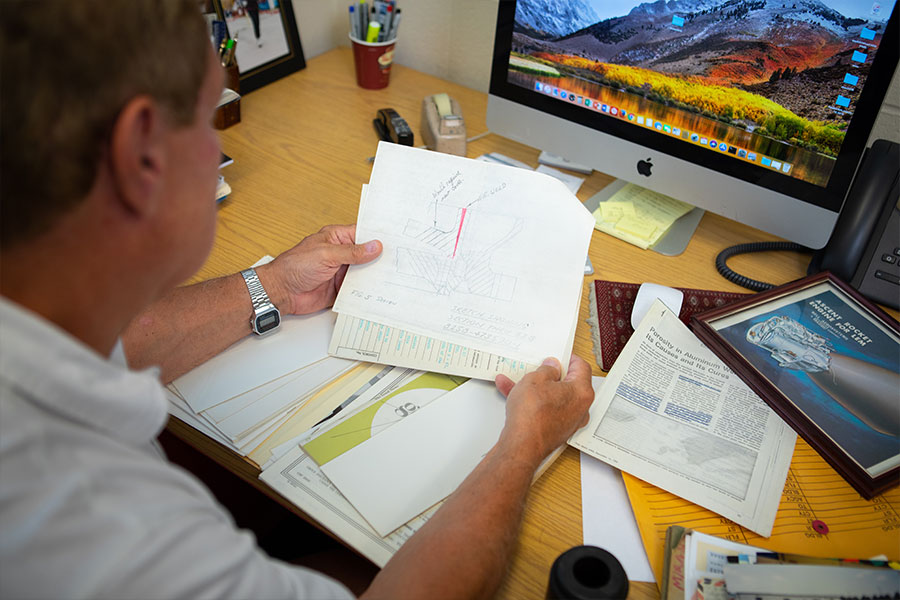Campus News
UB professor’s summer job in ‘66? The Apollo 11 moon mission

UB engineering professor Joseph Mollendorf in his Jarvis Hall office. He’s holding an illustration depicting Bell Aerosystems’ Lunar Excursion Module ascent rocket engine, which he worked on in the summer of 1966. Photo: Douglas Levere
By CHARLOTTE HSU
Published July 19, 2019 This content is archived.
On the third page of Joseph Mollendorf’s resume is a brief line describing a job he held in 1966 with Bell Aerosystems:
June 1966 – September 1966: Engineer, Apollo 11 Lunar Excursion Module Ascent Engine, Bell Aerospace, Wheatfield, NY.
Yep, that’s right: Mollendorf, now a SUNY Distinguished Teaching Professor in UB’s Department of Mechanical and Aerospace Engineering, had a summer job working on components for the Apollo 11 mission that put the first humans on the moon in July 1969.
At Bell, Mollendorf contributed ideas for improving the design of the rocket engine that would lift U.S. astronauts Neil Armstrong and Buzz Aldrin off the lunar surface. One focus of Mollendorf’s work was on reducing weld porosity, a phenomenon in which gases get trapped in metal, weakening the joints where different pieces of metal come together.
Mollendorf doesn’t know if any of his suggestions were implemented; he was one of many Bell engineers who worked on such problems.
Nevertheless, it was a special time.
“It was the summer of ’66. I had graduated from college,” Mollendorf recalls. “I was going to Cornell in the fall, and I had this summer job. And what did I work on? The ascent rocket engine for the Lunar Excursion Module.”
Three years later, when Armstrong, Aldrin and fellow U.S. Astronaut Michael Collins made their historic trip to the moon, “I remember watching it on TV and thinking, ‘God, I hope this thing works,’” Mollendorf says. “And it worked beautifully.”
Seeing the astronauts on the moon “put the whole thing in perspective,” he adds. “I suddenly realized the importance of what I had worked on.”
As the world marks the 50th anniversary of the July 20, 1969 moon landing, Mollendorf looks back with pride on the small contribution he made toward reaching that historic milestone.
The Apollo 11 mission was a national endeavor, a project that brought people in the United States together, a “unifying goal,” he says.
On a personal level, the job at Bell not only challenged Mollendorf to put his engineering skills to use. He also learned a lot about the workplace: He reported to John Kelly, head of the group building the ascent engine, an experience that showed Mollendorf what it takes to manage a team.
Creativity was prized at Bell, and at one point, the engineers received printed materials on how to brainstorm. Mollendorf still has these documents, tucked away in a folder filled with papers from his time at Bell.
Also in this file: carbon copies of handwritten suggestions he submitted to the company. These include a message on the potential benefits of adopting technologies that could help employees locate each other within Bell’s massive facilities. (In 1966, if you had a question for a colleague, it was often a time-consuming endeavor to hunt that person down if they weren’t at their desk.)
The work at Bell — and the Apollo 11 mission — were thrilling because of Mollendorf’s lifelong love of flight.
He recalls that when he was maybe 3 or 4, he and his father would make kites with paper from dry cleaning bags, using a paste of flour and water as glue.
One of the highlights of his 1966 summer job with Bell wasn’t related to the moon mission at all: Mollendorf recalls that sometimes, he and fellow engineers would eat their lunches outside, and would see the rocket belt (known also as a jet pack) being piloted on Bell’s grounds.
Later, in the late 1980s and early 1990s, after joining the UB faculty, Mollendorf would organize annual paper airplane contests for high school students in Western New York. One year, U.S. Astronaut James Irwin came to attend practice sessions. Mollendorf still has a souvenir from the visit: a photograph of Irwin standing on the moon, signed, “Reach for you dreams. Aim high!”
“I have always been fascinated by flight,” says Mollendorf, who today is a licensed pilot and also flies model airplanes. “I don’t know if it’s from watching birds. My uncle taught me how to make a paper airplane when I was 5. I’ve had this my whole life.”
His work on the Apollo mission was part of that excitement: In 1966, he was a 22-year-old kid just out of college, and the job at Bell was an incredible, real-world experience: “They were going to put this thing on the moon,” he says, “and you got a chance to work on it.”










